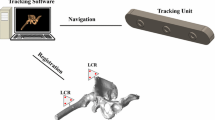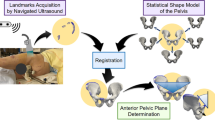Abstract
Objective
The aim of this study was to assess the accuracy of an imageless navigation system in localising the hip centre and to evaluate the effect of pelvic movement on the accuracy of hip centre acquisition.
Material and methods
A phantom leg was constructed to simulate the hip joint and upper femur. A 3D measurement device was used to measure precisely the co-ordinates of hip centre. A limber link simulated hip motion as used when defining the hip centre during computer-assisted surgery. The data generated by the 3D measurement device and the image-free navigation system was compared with increasing amounts of simulated pelvic movement.
Results
For moderate pelvic movement (5 mm) the mean error of the hip centre ranged between 1.5 mm and 3.9 mm with a corresponding angular error of between 0.25° and 0.64°. In conditions of excessive pelvic movement (15 mm) the mean error was 11.7 mm corresponding to an angular error of 1.9°.
Conclusion
This in vitro study showed accurate acquisition of the centre of hip with a surgical navigation system. These data suggest that during TKA using this computer assisted navigation system, the accuracy of insertion will not be significantly affected by moderate pelvic movement during data acquisition.




Similar content being viewed by others
References
Matziolis G, Krocker D, Weiss U, Tohtz S, Perka C (2007) A prospective, randomized study of computer-assisted and conventional total knee arthroplasty. Three-dimensional evaluation of implant alignment and rotation. J Bone Joint Surg Am 89(2):236–243
Tingart M, Luring C, Bathis H, Beckmann J, Grifka J, Perlick L (2008) Computer-assisted total knee arthroplasty versus the conventional technique: how precise is navigation in clinical routine? Knee Surg Sports Traumatol Arthrosc 16(1):44–50
Victor J, Hoste D (2004) Image-based computer-assisted total knee arthroplasty leads to lower variability in coronal alignment. Clin Orthop Relat Res 428:131–139
van Strien T, van der Linden-van der Zwaag E, Kaptein B, van Erkel A, Valstar E, Nelissen R (2009) Computer assisted versus conventional cemented total knee prostheses alignment accuracy and micromotion of the tibial component. Int Orthop 33(5):1255–1261
Kamat YD, Aurakzai KM, Adhikari AR, Matthews D, Kalairajah Y, Field RE (2009) Does computer navigation in total knee arthroplasty improve patient outcome at midterm follow-up? Int Orthop 33(6):1567–1570
Lustig S, Bruderer J, Servien E, Neyret P (2009) The bone cuts and ligament balance in total knee arthroplasty: the third way using computer assisted surgery. Knee 16(2):9
Marin F, Mannel H, Claes L, Durselen L (2003) Accurate determination of a joint rotation center based on the minimal amplitude point method. Comput Aided Surg 8(1):30–34
Chauhan SK, Scott RG, Breidahl W, Beaver RJ (2004) Computer-assisted knee arthroplasty versus a conventional jig-based technique. A randomised, prospective trial. J Bone Joint Surg Br 86(3):372–377
Mason JB, Fehring TK, Estok R, Banel D, Fahrbach K (2007) Meta-analysis of alignment outcomes in computer-assisted total knee arthroplasty surgery. J Arthroplasty 22(8):1097–1106
Saragaglia D, Picard F, Chaussard C, Montbarbon E, Leitner F, Cinquin P (2001) Computer-assisted knee arthroplasty: comparison with a conventional procedure. Results of 50 cases in a prospective randomized study. Rev Chir Orthop Reparatrice Appar Mot 87(1):18–28
Maculé-Beneyto F, Hernández-Vaquero D, Segur-Vilalta JM, Colomina-Rodríguez R, Hinarejos-Gomez P, García-Forcada I, Seral Garcia B (2006) Navigation in total knee arthroplasty. A multicenter study. Int Orthop 30(6):536–540
Manzotti A, Cerveri P, De Momi E, Pullen C, Confalonieri N (2010) Relationship between cutting errors and learning curve in computer-assisted total knee replacement. Int Orthop 34(5):655–662
Stindel E, Gil D, Briard JL, Merloz P, Dubrana F, Lefevre C (2005) Detection of the center of the hip joint in computer-assisted surgery: an evaluation study of the surgetics algorithm. Comput Aided Surg 10(3):133–139
Jeffery RS, Morris RW, Denham RA (1991) Coronal alignment after total knee replacement. J Bone Joint Surg Br 73(5):709–714
Ritter MA, Faris PM, Keating EM, Meding JB (1994) Postoperative alignment of total knee replacements: its effect on survival. Clin Orthop Relat Res 299:153–156
Picard F, Laitner F, Gregori A, Martin P (2007) A cadaveric study to assess the accuracy of computer-assisted surgery in locating the hip center during total knee arthroplasty. J Arthroplasty 22(4):590–595
Pitto RP, Graydon AJ, Bradley L, Malak SF, Walker CG, Anderson IA (2006) Accuracy of a computer-assisted navigation system for total knee replacement. J Bone Joint Surgery Br 88(5):601–605
Graydon AJ, Malak S, Anderson IA, Pitto RP (2009) Evaluation of accuracy of an electromagnetic computer-assisted navigation system in total knee arthroplasty. Int Orthop 33(4):975–979
Matziolis G, Krocker D, Tohtz S, Weiss U, Perka C (2006) Accuracy of determination of the hip centre in navigated total knee arthroplasty. Z Orthop Ihre Grenzeb 144(4):362–366
Mihalko WM, Philips MJ, Fishkin Z, Krackow KA (2006) Pelvic tracker effects on hip center accuracy using imageless navigation. Comput Aided Surg 11(4):214–218
Decking R, Markmann Y, Fuchs J, Puhl W, Scharf HP (2005) Leg axis after computer-navigated total knee arthroplasty: a prospective randomized trial comparing computer-navigated and manual implantation. J Arthroplasty 20(3):282–288
Acknowledgements
The authors would like to thank Damien Goy, Regis Capellaro and Frederic Marcelli for their help during experimentation.
Conflict of interest statement
All of the authors have received benefits from a commercial organisation (Tornier®) related to this study.
Author information
Authors and Affiliations
Corresponding author
Rights and permissions
About this article
Cite this article
Lustig, S., Fleury, C., Servien, E. et al. The effect of pelvic movement on the accuracy of hip centre location acquired using an imageless navigation system. International Orthopaedics (SICOT) 35, 1605–1610 (2011). https://doi.org/10.1007/s00264-010-1194-2
Received:
Accepted:
Published:
Issue Date:
DOI: https://doi.org/10.1007/s00264-010-1194-2




